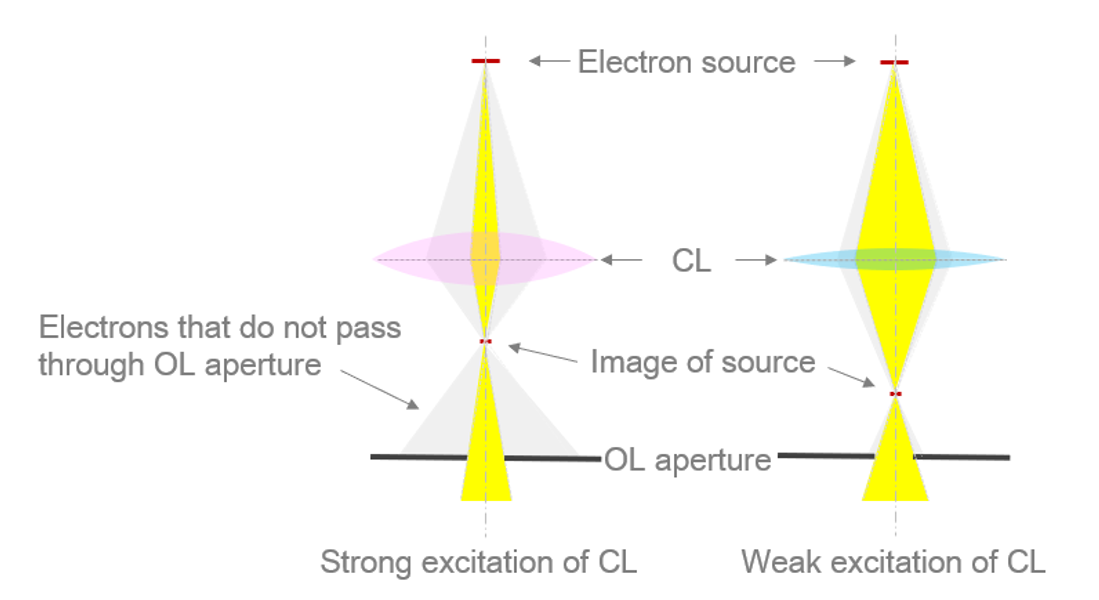集束レンズ
集束レンズ
condenser lens, CL
[目次:装置]
対物絞りと併用することでプローブ電流とプローブ径を制御するためのレンズ。
図に示すように、レンズの励磁を強くすると(左)対物絞りを通過する電子の量が少なく、励磁を弱くすると(右)対物絞りを通過する電子の量が多くなる。また、レンズの励磁を強くするとレンズの焦点距離が短くなり、プローブの縮小率は大きくなる。これらの機能を利用して、プローブ電流の制御と電子プローブ径の制御を行うことができる。通常は高分解能観察時には集束レンズを強励磁にしてプローブ径を小さくして用い、EDSなどの分析時には弱励磁にして電流量を大きくして用いる。
熱電子放出型電子銃を搭載したSEMでは、プローブ径を広範囲に制御するために、一般に複数段の集束レンズ系が使われる。熱電子放出型電子銃のクロスオーバー(光源)は約20µmと大きいので、1/1000程度に縮小する必要があり、大きな縮小率のレンズが要求される。ショットキー型電子銃を用いたSEMでは、光源が15~20nmと小さいため、レンズの縮小率は小さくてよい。他方、電界放出型電子銃を用いたSEMでは、光源は十分小さいので、集束レンズは、光源の縮小のためではなく、主にプローブ電流の制御に用いられる。プローブ電流の制御範囲が小さいため、普通1段の集束レンズが使われる。

図 集束レンズの励磁とその効果
The condenser lens is a lens that controls the probe current and probe-diameter by a combined use with the objective aperture.
As shown in Figures below, when the lens excitation is strong, the number of electrons passing through the objective aperture is small, whereas when the excitation is weak, the number of electrons passing through the aperture is large. Furthermore, when the lens is strongly excited, the focal length of the lens becomes short, and thus the electron probe size becomes small. Therefore, the probe current and probe diameter are controlled by the condenser-lens excitation. Normally, the condenser lens is strongly excited for high-resolution image observation to obtain a small probe size, and weakly excited for analysis such as EDS to obtain a large probe current.
An SEM equipped with a thermionic-emission gun uses the multi-stage condenser lens system to control the probe diameter in a wide range. Since the crossover (electron source) of this gun is as large as 20 µm, the crossover needs to be demagnified to about 1/1000 with a high reduction rate. An SEM equipped with a Schottky-emission gun has an electron source as small as 15 to 20 nm, and thus the lens with a low reduction rate is allowed. An SEM equipped with a field-emission gun has a sufficiently small source size. Thus, the condenser lens is mainly used to control the probe current with a one-stage condenser lens because the control range is small.

Fig. Excitation of the condenser lens and the effect of the excitation for the electron probe
関連用語から探す
説明に「集束レンズ」が含まれている用語






